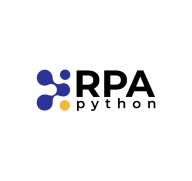


Blue Prism and Python RPA are competing RPA solutions. Blue Prism is often preferred for its seamless integration with enterprise systems, while Python RPA is valued for its flexibility and cost-effectiveness.
Features: Blue Prism includes robust audit and security capabilities crucial for compliance, facilitates integration with major enterprise applications, and provides a structured automation framework. Python RPA offers extensive libraries and community support, adaptability for custom automation needs, and a modular design suitable for diverse workflows.
Ease of Deployment and Customer Service: Blue Prism provides a guided deployment model with comprehensive technical support, suitable for established IT structures, whereas Python RPA allows greater deployment flexibility but may require more technical expertise. Blue Prism has structured customer service with dedicated support teams compared to Python RPA's community resource-based support options.
Pricing and ROI: Blue Prism requires a higher initial investment but offers a high ROI for large-scale operations due to its enterprise support package. Python RPA presents a lower-cost entry point, appealing to budget-conscious businesses, with the potential for quicker ROI due to minimal licensing fees and a gradual cost model.
Fortra's Automate has effectively replaced the workload of an entire employee, saving us significant time and money.
It has reduced our expenditures in terms of purchasing more products and employing more technicians.
I've seen a good return on investment with Automate, as it streamlines processes and improves my productivity.
We paid back within less than six months, and our cost for Blue Prism hasn't changed for the last 10 years.
Regarding ROI from Blue Prism, it is evaluated from a business perspective, with break-even timelines generally around six to nine months for large implementations, depending on client size and scale.
They don't always understand the processes I'm trying to implement.
I would rate the technical support as a nine out of ten because it is quite fast and courteous.
They are very responsive and have been able to resolve any issues I have encountered.
If we need to learn something about fixing a problem, improving a solution structure, they have something called knowledge management hours, where we can tap into their expertise to improve our processes or find different ways to build our solutions.
My experience with Blue Prism's technical support has been largely positive, with them being very responsive when needed, especially during the early stages of tool evolution.
The scalability of Automate also scores a ten out of ten.
It is easy to increase one bot or one studio without needing to buy another orchestrator, which can be quite expensive.
Automate is stable for my needs and is highly scalable, allowing the same workflow to serve numerous tasks effectively.
The digital workforce of Blue Prism has pioneered capabilities for scaling digital workforce members based on varied requirements, such as during the tax season when more digital robots are needed in the tax department, showcasing its scaling ability effectively.
The stability of the solution is a ten out of ten.
It has very robust features, and it is not prone to instability.
The stability of Fortra's Automate is excellent.
This is a significant concern, especially with critical workloads where visibility into errors is essential.
I would prefer not having to log in to update a ticket; being able to respond via email would be beneficial.
Integration with Amazon S3 is somewhat lacking.
I would like to see the interface of Blue Prism refreshed.
Competitors are often more expensive than Automate.
It offered what we wanted at a good, competitive price.
It does a lot but also costs a lot.
They don't charge per user or per environment, so you get everything you need included at one fixed cost.
While the licensing cost is something I haven't checked in a while, I find that although it initially seems costlier than competitors, Blue Prism's licensing model is simpler and proves to be cost-effective over time.
Automate's non-reliance on additional orchestrators makes it quite cost-effective.
In my opinion, the best feature Automate offers is the scheduling.
Automate's compatibility with existing IT infrastructure has impacted our business operations positively by providing smooth integration with other software that we use, such as Gmail, Jira, and Microsoft 365 apps, which gives us a unified platform instead of having to keep switching from one software to another, saving a lot of time and streamlining the whole workflows.
The tool is very robust and, being a pioneer in the sector, it is also very stable, particularly in finance where many companies rely on Blue Prism for its reliability and security standards.
The ability to scale quickly is also valuable, and their support is good in general.
| Product | Market Share (%) |
|---|---|
| Blue Prism | 8.1% |
| Automate | 2.0% |
| Python RPA | 2.0% |
| Other | 87.9% |



| Company Size | Count |
|---|---|
| Small Business | 18 |
| Midsize Enterprise | 8 |
| Large Enterprise | 5 |
| Company Size | Count |
|---|---|
| Small Business | 18 |
| Midsize Enterprise | 6 |
| Large Enterprise | 73 |
Automate offers a user-friendly solution with a drag-and-drop interface for efficient task automation and integration with major platforms like SAP and Azure, making it ideal for quick deployment with minimal coding and training.
Automate provides powerful features for businesses seeking efficient automation, offering compatibility with databases, email integration, and cloud platforms. Its simple interface supports both beginners and experienced users, simplifying tasks like invoice processing, HR automation, and data transformation. Cost-effective pricing and flexible licensing enhance its appeal while integration capabilities and scheduling tools ensure smooth workflow automation.
What are Automate's Key Features?In industries such as healthcare, banking, and logistics, Automate is used for tasks like invoice payment automation, data transformation, and task automation. This leads to streamlined processes and reduced manual workload, illustrating its value in enhancing operational efficiency through diversified workflows.
Blue Prism is an intelligent, business-developed, no-code automation platform for SaaS deployments as well as for on-premises, public cloud, multi-cloud, and hybrid environments. Unlike other automation technology, Blue Prism combines robotic process automation with expanded artificial intelligence and cognitive capabilities. Blue Prism gives users instant access to the tools you need for building and delegating automations, as well as a digital workforce that is already AI-equipped.
With Blue Prism’s code-free RPA, deployed through use of their Robotic Operating Model, your business can scale efficiently, improve customer satisfaction, reduce costs, and augment its talent to take on new responsibilities. Blue Prism helps to accelerate operational agility and efficiency by making it easy to automate the most important processes. Allocating everyday tasks to your Digital Workforce gives you immediate increased capacity and allows your teams to focus on their strategic goals. In addition, it delivers a return on investment, increases efficiency gains, and can even introduce new revenue streams.
“Workforce of the Future”
Blue Prism’s all-in-one intelligent automation platform consists of:
Reviews from Real Users
Blue Prism stands out for its enterprise-level functionality, which is why many companies choose it over its competitors. PeerSpot users note that the solution is easy to use, stable, and robust scalability-wise. The security is also top-notch. One user pointed out that "One of the most powerful features in Blue Prism is exception handling. It's one of the features that really differentiates it from other platforms." Blue Prism helps businesses with everything from compliance to quality control and error-avoidance.
Python RPA leverages the power of Python to automate repetitive tasks and workflows, offering a flexible and scalable solution. It's designed for integration across business processes, aiming to enhance efficiency and operational productivity with its versatile capabilities.
Python RPA is employed by businesses to streamline operations, reduce manual workload, and achieve cost savings. Combining Python's robust programming capabilities with automation, it appeals to companies looking to enhance their technology stack. Python RPA's strengths lie in its open-source nature that allows easy customization and a vast library of resources supporting automation tasks. This solution supports a wide range of applications, enabling seamless integration into existing systems and promoting innovation.
What are the key features of Python RPA?Python RPA finds applicability in industries like finance for transaction processing, healthcare for patient record management, and manufacturing for supply chain automation. Its adaptability allows companies to fine-tune the tool to sector-specific challenges, ensuring that automation objectives align with business goals.
We monitor all Robotic Process Automation (RPA) reviews to prevent fraudulent reviews and keep review quality high. We do not post reviews by company employees or direct competitors. We validate each review for authenticity via cross-reference with LinkedIn, and personal follow-up with the reviewer when necessary.